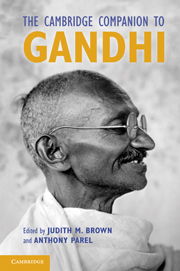12 - Gandhi’s global legacy
from Part III. - The contemporary Gandhi
Published online by Cambridge University Press: 28 May 2011
Summary
Gandhi has been understood in many ways since his death in 1948, and although his reputation has fluctuated, regard for him and his ideas has in general increased over time. He is revered by many as a spiritual leader and saintly figure. He is seen by others as a great pacifist. He is admired for his method of militant nonviolent resistance – satyagraha – and many have sought to apply it in struggles for civil and democratic rights. He has been held up as a champion of national liberation who has provided a potent means for resisting colonial rule. Others have appreciated his critique of the industrial mode of production and his call for a self-sustaining economy and egalitarian society. In this chapter, we shall see how Gandhi has proved an inspirational force for many, but also a controversial figure whose legacy has often been disputed.
Gandhi has been revered by many as a saintly figure who worked for peace and harmony in the world. This image is often found in depictions of him in the West. His statue in London, in Tavistock Square, thus shows him in a cross-legged meditative pose with eyes downcast. The impression is reinforced by flowers and incense sticks, which are often placed by his admirers at the foot of the statue. He is depicted in a similar way in a mural in St Mary’s Church in Oxford. In India, by contrast, he is normally depicted in statues as striding forth, staff in hand, about to battle the British in one of his satyagrahas. Many, particularly in the West, regard Gandhi as a kind of patron saint of pacifism. His reputation in this respect is, however, open to question. It has been pointed out that he in fact supported the British military in the Boer War and in World War I, and believed that it was better to defend national honour through the use of armed force than to act in a cowardly manner. This was hardly an endorsement of the pacifist position.
- Type
- Chapter
- Information
- The Cambridge Companion to Gandhi , pp. 239 - 257Publisher: Cambridge University PressPrint publication year: 2011
- 5
- Cited by

